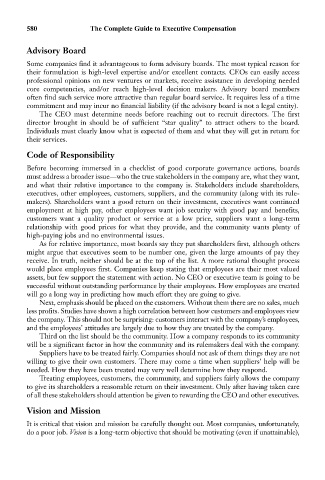Page 594 - Bruce Ellig - The Complete Guide to Executive Compensation (2007)
P. 594
580 The Complete Guide to Executive Compensation
Advisory Board
Some companies find it advantageous to form advisory boards. The most typical reason for
their formulation is high-level expertise and/or excellent contacts. CEOs can easily access
professional opinions on new ventures or markets, receive assistance in developing needed
core competencies, and/or reach high-level decision makers. Advisory board members
often find such service more attractive than regular board service. It requires less of a time
commitment and may incur no financial liability (if the advisory board is not a legal entity).
The CEO must determine needs before reaching out to recruit directors. The first
director brought in should be of sufficient “star quality” to attract others to the board.
Individuals must clearly know what is expected of them and what they will get in return for
their services.
Code of Responsibility
Before becoming immersed in a checklist of good corporate governance actions, boards
must address a broader issue—who the true stakeholders in the company are, what they want,
and what their relative importance to the company is. Stakeholders include shareholders,
executives, other employees, customers, suppliers, and the community (along with its rule-
makers). Shareholders want a good return on their investment, executives want continued
employment at high pay, other employees want job security with good pay and benefits,
customers want a quality product or service at a low price, suppliers want a long-term
relationship with good prices for what they provide, and the community wants plenty of
high-paying jobs and no environmental issues.
As for relative importance, most boards say they put shareholders first, although others
might argue that executives seem to be number one, given the large amounts of pay they
receive. In truth, neither should be at the top of the list. A more rational thought process
would place employees first. Companies keep stating that employees are their most valued
assets, but few support the statement with action. No CEO or executive team is going to be
successful without outstanding performance by their employees. How employees are treated
will go a long way in predicting how much effort they are going to give.
Next, emphasis should be placed on the customers. Without them there are no sales, much
less profits. Studies have shown a high correlation between how customers and employees view
the company. This should not be surprising: customers interact with the company’s employees,
and the employees’ attitudes are largely due to how they are treated by the company.
Third on the list should be the community. How a company responds to its community
will be a significant factor in how the community and its rulemakers deal with the company.
Suppliers have to be treated fairly. Companies should not ask of them things they are not
willing to give their own customers. There may come a time when suppliers’ help will be
needed. How they have been treated may very well determine how they respond.
Treating employees, customers, the community, and suppliers fairly allows the company
to give its shareholders a reasonable return on their investment. Only after having taken care
of all these stakeholders should attention be given to rewarding the CEO and other executives.
Vision and Mission
It is critical that vision and mission be carefully thought out. Most companies, unfortunately,
do a poor job. Vision is a long-term objective that should be motivating (even if unattainable),

